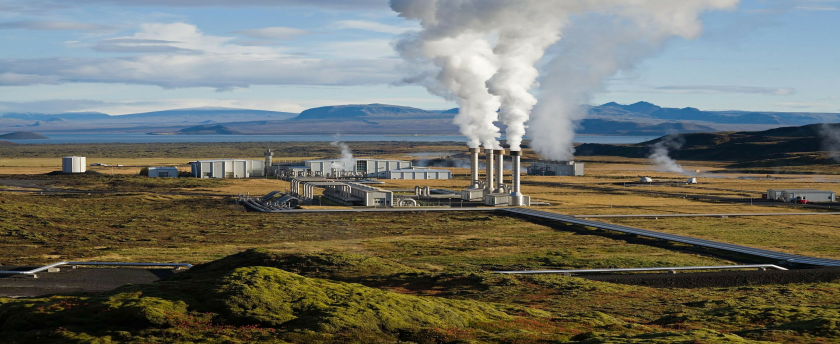
New Technology Is Promising!!
Geothermal power is cost effective, reliable, sustainable, and environmentally friendly, but has historically been limited to areas near tectonic plate boundaries. Recent technological advances have dramatically expanded the range and size of viable resources, especially for applications such as home heating, opening a potential for widespread exploitation. Geothermal wells release greenhouse gases trapped deep within the earth, but these emissions are much lower per energy unit than those of fossil fuels. As a result, geothermal power has the potential to help mitigate global warming if widely deployed in place of fossil fuels.
What Is Geo Thermal Industry
You don't here the term bantered around in general conversation even when talking about green energy and sustainable resources. The reasons for this vary from a lack of knowledge on the topic to the fact that until recently it has been cost prohibitive
.A second contributing fact is that geothermal energy is not totally green. It does release greenhouse gases into the atmosphere but at a much smaller rate then other fossil fuels.
Geothermal energy is thermal energy generated and stored in the Earth. Thermal energy is energy that determines the temperature of matter. Earth's geothermal energy originates from the original formation of the planet (20%) and from radioactive decay of minerals (80%). The geothermal gradient, which is the difference in temperature between the core of the planet and its surface, drives a continuous conduction of thermal energy in the form of heat from the core to the surface. The adjective geothermal originates from the Greek roots Geo, meaning earth, and thermos, meaning heat.
From hot springs, geothermal energy has been used for bathing since Paleolithic times and for space heating since ancient Roman times, but it is now better known for electricity generation. Worldwide, about 10,715 megawatts (MW) of geothermal power is on-line in 24 countries. An additional 28 gigawatt's of direct geothermal heating capacity is installed for district heating, space heating, spas, industrial processes, desalination and agricultural applications.
History
The oldest known pool fed by a hot spring, built in the Qin dynasty in the 3rd century BC. Hot springs have been used for bathing at least since paleolithic times. The oldest known spa is a stone pool on China's Lisan mountain built in the Qin dynasty in the 3rd century BC, at the same site where the Huaqing Chi palace was later built. In the first century AD, Romans conquered Aquae Sulis, now Bath, Somerset, England, and used the hot springs there to feed public baths and underfloor heating. The admission fees for these baths probably represent the first commercial use of geothermal power. The world's oldest geothermal district heating system in Chaudes-Aigues, France, has been operating since the 14th century. The earliest industrial exploitation began in 1827 with the use of geyser steam to extract boric acid from volcanic mud in Larderello, Italy.
In 1892, America's first district heating system in Boise, Idaho was powered directly by geothermal energy, and was copied in Klamath Falls, Oregon in 1900. A deep geothermal well was used to heat greenhouses in Boise in 1926, and geysers were used to heat greenhouses in Iceland and Tuscany at about the same time. Charlie Lieb developed the first down hole heat exchanger in 1930 to heat his house. Steam and hot water from geysers began heating homes in Iceland starting in 1943.
In the 20th century, demand for electricity led to the consideration of geothermal power as a generating source. Prince Piero Ginori Conti tested the first geothermal power generator on 4 July 1904, at the same Larderello dry steam field where geothermal acid extraction began. It successfully lit four light bulbs. Later, in 1911, the world's first commercial geothermal power plant was built there. It was the world's only industrial producer of geothermal electricity until New Zealand built a plant in 1958.
By this time, Lord Kelvin had already invented the heat pump in 1852, and Heinrich Zoelly had patented the idea of using it to draw heat from the ground in 1912. But it was not until the late 1940s that the geothermal heat pump was successfully implemented. The earliest one was probably Robert C. Webber's home-made 2.2 kW direct-exchange system, but sources disagree as to the exact timeline of his invention. J. Donald Kroeker designed the first commercial geothermal heat pump to heat the Commonwealth Building (Portland, Oregon) and demonstrated it in 1946. Professor Carl Nielsen of Ohio State University built the first residential open loop version in his home in 1948. The technology became popular in Sweden as a result of the 1973 oil crisis, and has been growing slowly in worldwide acceptance since then. The 1979 development of polybutylene pipe greatly augmented the heat pump's economic viability.
In 1960, Pacific Gas and Electric began operation of the first successful geothermal electric power plant in the United States at The Geysers in California. The original turbine lasted for more than 30 years and produced 11 MW net power.
The binary cycle power plant was first demonstrated in 1967 in the U.S.S.R. and later introduced to the U.S. in 1981. This technology allows the generation of electricity from much lower temperature resources than previously. In 2006, a binary cycle plant in Chena Hot Springs, Alaska, came on-line, producing electricity from a record low fluid temperature of 57 °C (135 °F).
Sustainability
Geothermal power is considered to be sustainable because any projected heat extraction is small compared to the Earth's heat content. The Earth has an internal heat content of 1031 joules (3·1015 TW·hr). About 20% of this is residual heat from planetary accretion, and the remainder is attributed to higher radioactive decay rates that existed in the past. Natural heat flows are not in equilibrium, and the planet is slowly cooling down on geologic timescales. Human extraction taps a minute fraction of the natural outflow, often without accelerating it.
Even though geothermal power is globally sustainable, extraction must still be monitored to avoid local depletion. Over the course of decades, individual wells draw down local temperatures and water levels until a new equilibrium is reached with natural flows. The three oldest sites, at Larderello, Wairakei, and the Geysers have experienced reduced output because of local depletion. Heat and water, in uncertain proportions, were extracted faster than they were replenished. If production is reduced and water is reinjected, these wells could theoretically recover their full potential. Such mitigation strategies have already been implemented at some sites. The long-term sustainability of geothermal energy has been demonstrated at the Lardarello field in Italy since 1913, at the Wairakei field in New Zealand since 1958, and at The Geysers field in California since 1960.
Falling electricity production may be boosted through drilling additional supply boreholes, as at Poihipi and Ohaaki. The Wairakei power station has been running much longer, with its first unit commissioned in November 1958, and it attained its peak generation of 173MW in 1965, but already the supply of high-pressure steam was faltering, in 1982 being derated to intermediate pressure and the station managing 157MW. At the turn of the century it was managing about 150MW, then in 2005 two 8MW isopentane systems were added, boosting the station's output by about 14MW. Detailed data are unavailable, being lost due to re-organisations. One such re-organisation in 1996 causes the absence of early data for Poihipi (started 1996), and the gap in 1996/7 for Wairakei and Ohaaki; half-hourly data for Ohaaki's first few months of operation are also missing, as well as for most of Wairakei's history.
Environmental Effects
Fluids drawn from the deep earth carry a mixture of gases, notably carbon dioxide (CO2), hydrogen sulfide (H2S), methane (CH4) and ammonia (NH3). These pollutants contribute to global warming, acid rain, and noxious smells if released. Existing geothermal electric plants emit an average of 122 kilograms (270 lb) of CO2 per megawatt-hour (MW·h) of electricity, a small fraction of the emission intensity of conventional fossil fuel plants. Plants that experience high levels of acids and volatile chemicals are usually equipped with emission-control systems to reduce the exhaust.
In addition to dissolved gases, hot water from geothermal sources may hold in solution trace amounts of toxic chemicals such as mercury, arsenic, boron, and antimony. These chemicals precipitate as the water cools, and can cause environmental damage if released. The modern practice of injecting cooled geothermal fluids back into the Earth to stimulate production has the side benefit of reducing this environmental risk.
Direct geothermal heating systems contain pumps and compressors, which may consume energy from a polluting source. This parasitic load is normally a fraction of the heat output, so it is always less polluting than electric heating. However, if the electricity is produced by burning fossil fuels, then the net emissions of geothermal heating may be comparable to directly burning the fuel for heat. For example, a geothermal heat pump powered by electricity from a combined cycle natural gas plant would produce about as much pollution as a natural gas condensing furnace of the same size. Therefore the environmental value of direct geothermal heating applications is highly dependent on the emissions intensity of the neighboring electric grid.
Plant construction can adversely affect land stability. Subsidence has occurred in the Wairakei field in New Zealand and in Staufen im Breisgau, Germany. Enhanced geothermal systems can trigger earthquakes as part of hydraulic fracturing. The project in Basel, Switzerland was suspended because more than 10,000 seismic events measuring up to 3.4 on the Richter Scale occurred over the first 6 days of water injection.
Geothermal has minimal land and freshwater requirements. Geothermal plants use 3.5 square kilometres (1.4 sq mi) per gigawatt of electrical production (not capacity) versus 32 square kilometres (12 sq mi) and 12 square kilometres (4.6 sq mi) for coal facilities and wind farms respectively. They use 20 litres (5.3 US gal) of freshwater per MW·h versus over 1,000 litres (260 US gal) per MW·h for nuclear, coal, or oil.
Economics
Geothermal power requires no fuel (except for pumps), and is therefore immune to fuel cost fluctuations, but capital costs are significant. Drilling accounts for over half the costs, and exploration of deep resources entails significant risks. A typical well doublet (extraction and injection wells) in Nevada can support 4.5 megawatts (MW) and costs about $10 million to drill, with a 20% failure rate.
In total, electrical plant construction and well drilling cost about 2-5 million € per MW of electrical capacity, while the break–even price is 0.04-0.10 € per kW·h. Enhanced geothermal systems tend to be on the high side of these ranges, with capital costs above $4 million per MW and break–even above $0.054 per kW·h in 2007. Direct heating applications can use much shallower wells with lower temperatures, so smaller systems with lower costs and risks are feasible. Residential geothermal heat pumps with a capacity of 10 kilowatt (kW) are routinely installed for around $1–3,000 per kilowatt. District heating systems may benefit from economies of scale if demand is geographically dense, as in cities, but otherwise piping installation dominates capital costs. The capital cost of one such district heating system in Bavaria was estimated at somewhat over 1 million € per MW. Direct systems of any size are much simpler than electric generators and have lower maintenance costs per kW·h, but they must consume electricity to run pumps and compressors. Some governments subsidize geothermal projects.
Geothermal power is highly scalable: from a rural village to an entire city.
Chevron Corporation is the world's largest private geothermal electricity producer. The most developed geothermal field is the Geysers in California.


